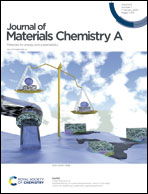Constructing 2D MOFs from 2D LDHs: a highly efficient and durable electrocatalyst for water oxidation†
Abstract
Two-dimensional (2D) materials have been widely applied in electrochemical conversion technologies, especially toward the water oxidation reaction (WOR) in metal–air batteries and water splitting. Here, we demonstrate a facile ligand-assisted synthetic method, promoting the transformation of 2D layered double hydroxides (LDHs) into 2D metal–organic frameworks (MOFs). The CoFe-LDH precursor acts as an adjustable metal release source, controlling heterogeneous nucleation for 2D MOFs. Compared with most cobalt-based electrocatalysts, the optimized CoFe 2D MOFs exhibit a superior WOR performance on glassy-carbon electrodes (overpotential of 274 mV at 10 mA cm−2 and a Tafel slope of 46.7 mV dec−1) and long-term stability, due to the unique 2D characteristics and coupling effect between Co and Fe ions. More importantly, this work highlights the ability to transform 2D LDHs into 2D MOFs and reveals the intrinsic factors for excellent performance in the WOR.



 Please wait while we load your content...
Please wait while we load your content...